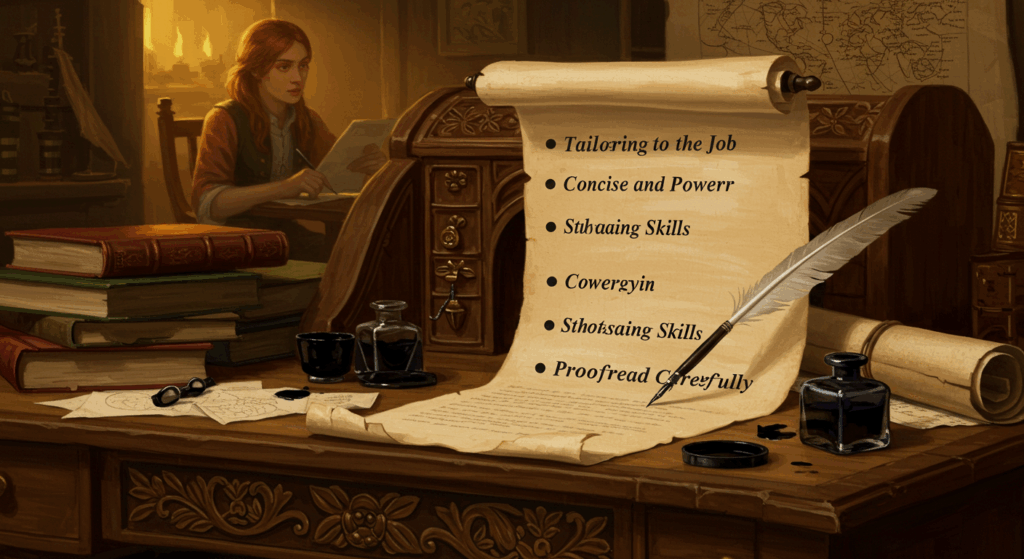If cover letters were a dating app, they’d be “the message before the date.” Your résumé is the profile; the cover letter is where you slide into the recruiter’s DMs (politely!) and say, “Here’s why we’d be great together.” And yeah, I get it—writing one can feel like staring at a blank Google Doc while your brain plays elevator music. But once you get the rhythm—introduction → job-specific content → closing—it starts to click. Ngl, it can even be kinda fun. Like, “I get to brag about myself but strategically? ok!”
This guide is the no-BS, friend-to-friend version. We’ll talk tone (conversational but professional), structure (three clean parts), and receipts (numbers, outcomes, proof). I’ll give you examples, line-by-line prompts, and several templates, so you can copy-paste, tweak, and hit submit without stress. Let’s make a letter that sounds like you—not a corporate robot that just discovered Grammarly.
Big Picture: Why Cover Letters Still Matter
Quick reality check: some recruiters read every cover letter, some skim, and some never open them. That’s okay. You’re writing this for the ones who do—and because a great letter can:
- Explain your story (career change, gap year, new industry).
- Connect your résumé bullets to the company’s actual needs.
- Show you can communicate like a human (huge green flag).
- Add job-specific content that ATS might miss but a person will love.
- Seal the deal with a strong closing that nudges a reply.
Think of it like bonus content on a streaming platform—optional, but often the good stuff is there.
The 3-Part Roadmap: Introduction → Job-Specific Content → Closing
Memorize this. Screenshot it. Tattoo it (jk don’t). A clean cover letter usually fits on one page (about 250–450 words) and follows this arc:
- Introduction: Who you are + the role you’re applying for + 1–2 lines of tailored value.
- Job-Specific Content: The “why me for this job at this company” body. Proof, metrics, and fit.
- Closing: Quick wrap, energy, call-to-action, and sign-off.
Once you can hit those beats, you can write for any role. Different flavors, same recipe.
Pre-Game: Two Quick Moves That Save You 30 Minutes
1) Skim the job post like a detective.
Circle verbs and nouns: tools (Figma, Python, HubSpot), outcomes (pipeline growth, retention), priorities (customer obsession, experimentation). These become your job-specific content hooks.
2) Write your “two-sentence brag.”
This is your micro elevator pitch. It often becomes your introduction:
- “I grow B2B inbound pipeline with content + SEO, and I’ve shipped campaigns that drove 40% more trials in 90 days.”
- “I’m a customer-first support lead who turns messy processes into repeatable playbooks; my last team cut resdolution time by 28%.”
Keep that handy. You’ll use it often.
Formatting 101 (So Your Letter Looks Like It Knows What It’s Doing)
- Length: Aim ~300–400 words. Tight, scannable paragraphs (2–5 sentences each).
- Font: 11–12 pt system fonts (Calibri, Arial, Georgia). Keep it simple.
- Margins: ~1 inch. White space is your friend.
- Header: Match your résumé header for visual consistency.
- File name:
FirstName-LastName-CoverLetter-Company.pdf(PDF unless they ask Word). - Greeting: If unsure, default to “Hi [Team/Name],” or “Dear Hiring Team,” (yep, “Hi” is fine in 2025).
The Introduction: Start Strong Without Sounding Like a Template
You get 2–3 lines to hook them. No “To whom it may concern” vibes. Use one relevant proof point and mention the role:
Template you can tweak
Hi [Name/Team], I’m a [role/identity—keep it short] who [value/outcome]. I’m excited to apply for the [Job Title] role at [Company]—especially because [specific reason you care about them].
Example
Hi Alex, I’m a content marketer who turns keyword research into revenue. I’m applying for the Content Lead role at Loop because your product-led growth focus matches how I’ve scaled organic trials by 38% in my last role.
Another example (career switch)
Dear Hiring Team, I’m a former teacher pivoting into UX research. I’m applying for the UX Researcher role at Craft because your emphasis on accessibility testing aligns with the inclusive design projects I’ve led for classrooms of 30+ diverse learners.
The trick: a real reason you like them + one result you’ve delivered. That’s a great introduction—short, human, confident.
The Heart: Job-Specific Content That Proves You Fit
This is your middle section (2–3 short paragraphs or a tight bullet list). Connect your experience to what the job post is actually asking for. Use numbers, outcomes, and tools. Think “show, don’t tell.”
Three angles you can mix:
A) Mirror their priorities
Your posting emphasizes [priority 1, 2, 3]. In my current role at [Company], I [what you did], which resulted in [metric]. I also built [thing] that helped [stakeholder] achieve [result].
B) Case study lite
At [Company], I led [project], where we [action]. We shipped [deliverable], and in 60 days we saw [result]. I collaborated with [teams] and used [tools]. This matches your need for [requirement].
C) Transferable skills (if changing fields)
While my background is in [previous field], the core skills—[analysis, stakeholder management, user interviews, writing, etc.]—map directly to [new role]. For example, I [concrete action] that led to [quantifiable result], which parallels your goal of [what they want].
Bullet-style (scannable) option
- Drove +31% MQLs in Q2 through a refresh of top-funnel content and updated CTAs.
- Built a cross-functional workflow with Sales to tighten feedback loops; cut lead response time by 22%.
- Owned keyword strategy; moved 11 URLs to page 1 in 90 days using topic clusters.
Your job-specific content should feel like: “You asked for X, I did Y, here’s proof.” Keep it clean and skip fluff like “I’m a hard worker.” (Everyone says that. Show it.)
The Closing: Ask for the Next Step (Without Being Weird)
End with momentum. Reaffirm fit, express interest, and invite a chat. One short paragraph.
Template
Thanks for reading—would love to talk about how I can help [Company] hit [specific goal]. If helpful, I’m happy to walk through [project/work sample]. Appreciate your time!
Example
Thanks for taking a look. I’d love to help Loop 2x organic signups in 2025 and can share my content roadmap approach that grew trials 38% last year. Hope to chat soon!
Add a confident sign-off (“Warmly,” “Best,” “Cheers,” “With appreciation,”) and your name + links.
Put It Together: A Quick, Polished Example (You Can Adapt)
Hi Maya,
I’m a lifecycle marketer who blends data with creative testing to grow revenue. I’m applying for the Lifecycle Marketing Manager role at Heliotrope because your push into subscription bundles fits the work I did to increase LTV by 19% last year.In my current role at Beacon, I rebuilt our onboarding sequence based on segment behavior. We shipped a 4-email flow that lifted Week-2 activation by 27%. I also launched monthly upgrade nudges driven by product usage thresholds; together, these increased trial-to-paid by 6.3% QoQ.
Your posting calls for experimentation, cross-team collaboration, and comfort with tools like Iterable and Looker. I’ve led 20+ A/B tests across channels, partner closely with PMs and Support, and work daily in Iterable, Amplitude, and BigQuery. I’ve attached a brief memo that outlines the onboarding experiments I’d start at Heliotrope.
Thanks for reading—I’d love to help you hit your 2025 retention target and can walk through the experiments above in more detail.
Best,
Jordan Reyes
[LinkedIn] · [Portfolio] · [Site]
Notice how it hits the introduction, packs in job-specific content, and ends with an inviting closing.
Line-By-Line Prompts (So You’re Never Stuck)
- Greeting: “Hi [Name/Team],”
- Introduction sentence 1: “I’m a [role] who [value you deliver].”
- Introduction sentence 2: “I’m applying for [title] at [company] because [specific reason].”
- Body paragraph 1: “Recently at [company], I [action] → [result]. This matters because [tie to their needs].”
- Body paragraph 2: “You need [requirement]; I’ve done [evidence, tools, collabs].”
- Optional bullets: 2–4 proof points with metrics.
- Closing: “Thanks for reading—would love to help [company] achieve [goal]. Happy to share [asset].”
- Sign-off + name + links.
Copy these into a doc and fill them in. Works for like 90% of roles, fr.
Tone: Conversational, Not Casual-Casual
You can be warm and modern while staying professional. Think “Slack at work,” not “group chat at 2am.” A few tips:
- Use you and we more than I (reader-focused).
- Sprinkle one or two casual phrases (“I’d love to,” “happy to chat”), not a TikTok monologue.
- Keep it positive—skip shade at past employers.
- Avoid filler like “I believe that I think that…” Just… say the thing.
Rookie Mistakes (and Easy Fixes)
- Too long. Fix: 300–400 words, tops.
- No nouns from the job post. Fix: mirror 4–6 exact terms in your job-specific content.
- Vague claims. Fix: replace “helped” with an action verb + metric.
- One-size-fits-all letter. Fix: 10–15 minutes tailoring per app (seriously worth it).
- Weak closing. Fix: ask for a chat and reference how you’ll add value, then sign off cleanly.
Advanced: Three Micro-Frameworks for Job-Specific Content
The CAR Method (Context–Action–Result)
Context: “Conversion from free → paid plateaued at 8%.”
Action: “Segmented onboarding by job-to-be-done and tested two CTA variants.”
Result: “Free → paid rose to 11.4% in 8 weeks.”
The “3 Most Relevant Things”
“You asked for [A], [B], [C]. I’ve done [A] at [metric], [B] with [tool], and [C] by [collaboration].”
The “Before → After → Bridge”
“Before, NPS was 24. After, it’s 41. Bridge: rolled out a CSAT program + feedback loops + a new help center.”
Use whichever feels natural. They all make your job-specific content feel concrete.
Shortcuts for Common Scenarios
New Grad / Internship
- Lean on projects, clubs, research, capstones, and part-time work.
- Show you can learn fast and collaborate.
Snippet
As a CS senior, I shipped a React app for a 5-person capstone and led the CI/CD setup; we reduced deployment time from hours to minutes. I’m excited to bring that builder energy to [Company]’s platform team.
Career Changer
- Map transferable skills directly: communication, analysis, leadership, stakeholder mgmt., systems thinking.
Snippet
As a teacher, I designed data-driven lesson plans for 150+ students. That same skill—turning data into personalized experiences—applies to lifecycle marketing, where I’ve already built a sample onboarding flow (attached) using customer events.
Returning to Work
- Be honest but forward-looking.
Snippet
After a family leave in 2023–2024, I’m excited to return to product ops. I kept skills sharp with an operations certificate and contributed to two volunteer analytics projects; both are linked below.
Examples by Role (Steal the Shape, Swap the Details)
Software Engineer
- Introduction: “Full-stack dev who ships fast, tests well.”
- Job-Specific Content: “At Alto, built a feature flag system; reduced rollout risk, increased deploy frequency from weekly to daily.”
- Closing: “Happy to demo the system; would love to help you hit weekly deploys.”
Sales (AE)
- Introduction: “Quota-crushing AE with 130%+ attainment.”
- Job-Specific Content: “Built territory plan, sourced 45% of pipeline from outbound; avg deal cycle down 14 days.”
- Closing: “Would love to show the territory model and talk 2025 goals.”
People Ops / HR
- Introduction: “People Partner focused on retention and manager enablement.”
- Job-Specific Content: “Launched manager bootcamp; regrettable attrition dropped from 17% → 12% YoY.”
- Closing: “Can share playbooks and training assets on request.”
Make Metrics (Even If You Don’t Live in Dashboards)
No numbers? You probably have some—just not in a dashboard. Try:
- Scale: How many customers, tickets, students, pages, repos, etc.?
- Speed: How much faster now vs. before?
- Quality: Fewer bugs, higher CSAT, better reviews?
- Money-ish: Saved cost, increased conversion, improved LTV/CAC proxy?
- Adoption: % of team using your process, number of users on new feature.
Even one number in your introduction or job-specific content levels you up instantly.
Keyword-Friendly Headings (Use Them If You’re Organizing a Long Post)
If you’re putting this on a blog or portfolio—and want it to be SEO-clear—sections like these help:
- How to Write a Cover Letter: introduction, job-specific content, closing
- Introduction Examples That Don’t Sound Robotic
- Job-Specific Content: Proof You’re the Fit
- Closing Lines That Actually Get Replies
You don’t need to stuff keywords. Just let “introduction,” “job-specific content,” and “closing” show up naturally in headings and sentences where they belong. (See what I did there?)
Tiny Style Tweaks That Read as “Pro”
- Use title case in the job title the company listed (“Product Marketing Manager,” not “product marketing manager”).
- Mirror the company’s tone a little (playful vs. formal).
- If you link a portfolio, add quick labels like “Case study: Onboarding 2.0 (3 min read).”
- Keep paragraphs short and mobile-friendly. Recruiters read on phones too (yes, in line at Starbucks).
Quick Tailoring Checklist (10 Minutes, Tops)
- Company name and role are correct (pls don’t get ghosted by a copy-paste error).
- Your introduction names one result and one real reason you like them.
- Your job-specific content mirrors 4–6 terms from the posting.
- You included at least one number (or scale/scope).
- Your closing asks for a chat and hints at how you’ll help.
- Links work. File name is clean. Tone is you.
A Fill-In-The-Blanks Template (Copy > Paste > Personalize)
Hi [Name/Team], I’m a [your role or identity—short] who [value you deliver]. I’m applying for the [exact Job Title] role at [Company] because [specific, true reason].
Recently at [Current/Last Company], I [action you took]. That led to [metric/result—numbers if possible]. I also [second action] using [tools/process], which helped [stakeholder/team] achieve [result].
Your posting mentions [requirement A], [requirement B], and [requirement C]. I’ve done [A] by [proof], [B] with [proof], and [C] through [proof]. If helpful, I can share [portfolio/sample/brief] that outlines how I’d approach [company goal or problem].
Thanks for reading—would love to help [Company] reach [specific outcome in 2025]. Happy to chat and walk through more details.
Best,
[Your Name] · [LinkedIn] · [Portfolio] · [Site]
Power Verbs (Drop These Into Your Job-Specific Content)
Shipped, orchestrated, refactored, streamlined, scaled, accelerated, launched, audited, prioritized, negotiated, implemented, optimized, automated, piloted, validated, reduced, increased, expanded, enabled, coached, mentored, partnered, designed, prototyped, evangelized, documented.
Pick a few that feel right. Don’t overdo—this isn’t a thesaurus cosplay.
Alternate Openers (Because Not Every Introduction Should Sound the Same)
- “I’m excited about the [Role] at [Company]—especially your work on [feature/mission]. Last year I [result], and I’d love to bring that to your team.”
- “As a [role], my happy place is the intersection of [skill] and [skill]. That’s why this [Role] at [Company] stood out.”
- “After following [Company] since your [launch/funding/initiative], I’m applying for [Role]. I’ve led similar [projects/outcomes] like [example].”
Alternate Closing Lines That Feel Fresh
- “If helpful, I can send a 1-page teardown of your [funnel/feature/campaign] with quick wins.”
- “I’d love to partner with [team] to help you hit [goal]—when’s a good time to chat?”
- “Thanks for considering—I’m excited to learn more and share specifics on [project/result] if useful.”
Special Section: When You’re Applying Cold vs. Referred
- Cold apply: Use the letter to show you did homework and you get their vibe. Include one insight.
“I noticed you expanded into APAC; I’ve shipped localized onboarding for ID/PH/VN—happy to share what worked.” - Referred: Name the referral lightly in your introduction.
“I learned about this role from Priya Shah on your Sales Ops team; we partnered at Alto on a territory project.”
Tiny “Human Touches” That Make a Big Difference
- Mention a recent product launch (briefly).
- Referemce a value that actually resonates (not just “we love teamwork”).
- Attach a 1-pager or link (when appropriate): roadmap sketch, teardown, case study.
- Keep the energy: confident but not cocky, enthusiastic but not thirsty.
One More Full Example (Ops / Program Management)
Hi Hiring Team,
I’m an ops lead who turns chaos into repeatable systems. I’m applying for the Program Operations Manager role at Orbit because your scale-up phase (Series B, new product lines) is exactly where I’ve built PMO practices that keep shipping on track.At LatticeWorks, I centralized our intake process across 6 teams and launched a lightweight RICE scoring model. We cut “ghost projects” by 42% and increased on-time delivery from 63% → 86% in two quarters. I also created a weekly risk review with Engineering and CX that flagged blockers earlier; cycle time dropped 18%.
Your posting calls for portfolio visibility, cross-functional planning, and strong tooling. I’ve implemented Asana + Mode dashboards for exec visibility, trained 40+ ICs on project hygiene, and partnered with Finance to align roadmap capacity with quarterly budgets. I’m including a 1-page example of the intake template I’d propose for Orbit (happy to talk through it).
Thanks for your time—I’d love to help Orbit scale with fewer fire drills in 2025.
Cheers,
Morgan Lee
[LinkedIn] · [Portfolio]
Again: crisp introduction, tight job-specific content, clear closing. Done.
FAQ-ish Rapid Fire (Because You’ll Ask Anyway)
- Do I need a cover letter if they don’t ask for one? If there’s a place to upload it, it usually helps—especially if your résumé needs context.
- Should I use AI to draft? Sure, but personalize the introduction, add real job-specific content, and write your own closing so it sounds like… you.
- What if I don’t know the hiring manager’s name? Check LinkedIn or the job post; if not, “Hi [Team/Company] Hiring Team,” is totally fine.
- Can I use bullets? Yep. One paragraph + 3 bullets is very scannable.
- Can I add a P.S.? Low-key hack: a short P.S. can land. “P.S. Happy to share a teardown of your onboarding—found three quick wins.”
Final Quality Check (60 Seconds Before You Hit Submit)
- Does the introduction mention the exact role + one relevant win?
- Does the job-specific content echo the job post with real proof?
- Does the closing invite a conversation and show enthusiasm?
- Typos fixed (mostly… a couple human quirks are fine, hmm).
- File is PDF (unless they ask otherwise). Links all work.
Wrap-Up: You’ve Got This (And You’re Closer Than You Think)
If you remember nothing else, remember this: a good cover letter is just a short story with three beats—introduction, job-specific content, closing. Start with a human hello. Prove you can solve their problems with your receipts. End by nudging the next step. That’s it. No Shakespeare, no essay contest, just a crisp note from a strong candidate (you).
Take a breath, open your doc, and draft the first messy version. Then tighten it. Two passes, 20 minutes, done. You’ll feel better, and your application will stand out in a stack of “To whom it may concern” clones.
Go write it—and when you land that interview, come back and I’ll help you prep your answers too. You’ve got this.









